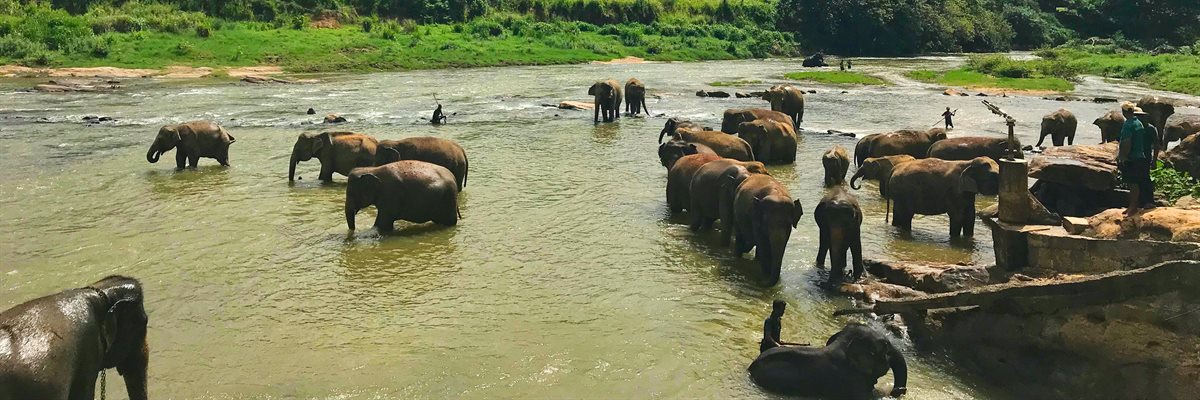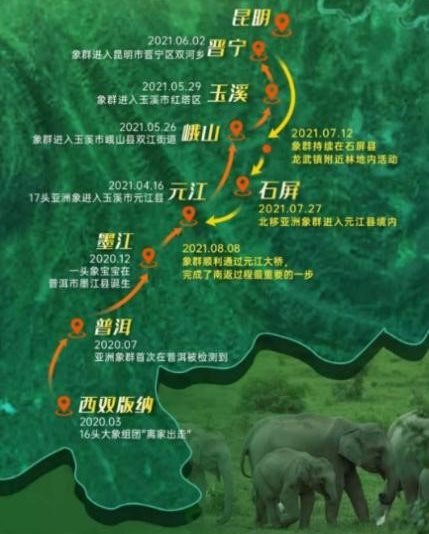The Elephants' Journey: How they trekked across China and made a safe return
Li Li, Bin Wu and Le Yang
Forests are not only crucial for carbon emission reduction and sequestration, but also serve as the natural habitats of wild animals. As one of the most populous developing countries in the world[2], China is facing huge challenges to balance economic growth and biodiversity protection. This is particularly true in its remote and mountainous margins and poverty-stricken rural areas, mainly located in western China. In this article, however, our researchers examine a recent incident that provides some hope for improvement.

The biodiversity challenge
Since the 1970s, China has been implementing policies to protect biodiversity with notable successes. The number of giant pandas (Ailuropoda melanoleuca) in China has increased from 1,114 to 2,060 in 2016, moving from an endangered (EN) to vulnerable (VU) species according to IUCN's Red List.[3] In 2021, the number of tibetan antelopes (Pantholops hodgsonii) in China has increased from less than 70,000 in the 1980s to over 300,000, reducing from EN to “near threatened (NT)” species.[4] Population of the asian elephants (Elephas maximus) has grown from 180 to 360 or so.[5] And the number of hainan gibbons (Nomascus hainanus) has increased from less than 10 to 35.[6]
These success stories, however, have led to further problems. Serious tensions are emerging as the growth of endangered species conflicts with the livelihood security and safety of local communities.
Serious tensions are emerging as the growth of endangered species conflicts with the livelihood security and safety of local communities.
The rising population of the asian elephants, for example, has led to increased injuries for local farmers. According to official figures, asian elephants in Yunnan, a border Province alongside Laos, killed 15 rubber tapping farmers in 2020 and injured 12 more, up from 13 and 4 respectively in 2019. This is because key foraging times, early morning in the rain forests, coincide with farmer’s rubber tapping hours. Agricultural crops are also frequently eaten by the elephants.[7]
These conflicts prompt the question of: “How to balance biodiversity conservation against livelihood security?” A potential answer to this question may be found in the recent story of one asian elephant group.
The journey of the asian elephants
In March 2019, a group of sixteen asian elephants left their home in Xishuangbanna National Nature Reserve. They walked north to a suburban district of Kunming, the provincial capital of Yunnan, before heading back to the reserve safely on August 8, 2021.
This trip lasted 17 months, covering nearly 1,300 kilometers. No group members were lost, infact a new baby elephant joined the ranks in December 2020.
So how did this troop manage to travel so far without incident?
The journey attracted both national and international attention, with over a billion Chinese people watching via TV channels, WeChat Moments, and other media. It even featured on the 2022 Spring Festival Gala, the most influential event to mark the lunar New Year for tens of millions of Chinese people globally.
It therefore received an unprecedented level of support.
What can we learn from this?
There are lessons that need to be learned from this on how governments, social organisations, enterprises, research institutions, and many other interested groups can work together with smallholder farmers to protect biodiversity in marginal areas of China and other countries in South and Southeast Asia.

Infographic showing the route of the elephant migration
Key approaches:
1. A public-private partnership for joint action.
From the public sector, over 25,000 staff and 973 unmanned aerial vehicles (UAVs) were deployed to monitor and provide accurate information. Overall, more than 15,000 emergency vehicles were mobilised, over 15,000 residents were evacuated, and nearly 180 tons of food were provided.
Environmental non-government organizations also pioneered community-based solutions, including setting up “elephant canteens”, restoring the rainforest ecology and more.
2. Digital monitoring and early warning system for elephant protection.
A national-level “Northward Asian Elephant Monitoring and Early Warning” project was launched in the Reserve. According to Yunnan Forestry and Grass Bureau, the total investment was about 29.7 million RMB yuan (£3.56 million). This enabled individual elephants to be accurately tracked and monitored in all conditions, allowing for forward planning to minimise problems.
3. Economic support for affected villagers
The economic loss caused by asian elephants in Xishuangbanna Prefecture is estimated at around 6 million RMB yuan (£0.72 million) each year. The Chinese government provides compensation for loss of crops or property caused by wild animals, but these subsidies are insufficient. In November 2009[GB3] , however, the first Wildlife Public Liability Insurance (WPLI) was introduced. During the elephants’ trip, there were 1,501 accepted complaints, totaling nearly 2 million RMB yuan ( ~£0.24 million) in additional compensation.
Meanwhile, new businesses were also introduced as alternative livelihoods to local villages, such as Chinese bee rearing, traditional Dai medicine, pepper plantation, or rural tourism. These provide alternative sustainable livelihoods to replace rubber tapping.
These factors mitigated the damage and disruption caused by the elephants, reducing negative impacts and conflicts.
Implications and conclusions
Although its timing just before COP15 in Kunming during October 2021 was a coincidence, the safe journey of these elephants suggests a new phase of biodiversity protection in China. It demonstrates the need for public awareness, multiple stakeholders’ cooperation, and partnerships with local communities.
In the context of biodiversity protection in marginal areas of the Global South, this case sheds new light on the conditions and mechanisms for participation and the potential contributions of digital systems. It demonstrates the importance of partnerships established between public and private sectors, between government agencies, local non-government organizations (NGOs), industrial companies and local communities for collective action of bio-conservation. This shows the potential for positive outcomes when appropriate support is supplied, suggesting that a better balance between biodiversity and sustainable livelihoods is possible.
This shows the potential for positive outcomes when appropriate support is supplied, suggesting that a better balance between biodiversity and sustainable livelihoods is possible.
In future, more innovative efforts need to be made to make indigenous knowledge explicit, by utilising cultural and natural heritages as newly valued livelihoods, is the key to establish “Global-Local” links leading to a process of bottom-up development and sustainable bio-conservation. Local NGOs, with their inborn empathetic capacity to realize bottom-up “surprise hits”, are can-do actors in building trusts among “outsiders” and “insiders”.
The kernel part for tackling the hardest challenge through small-scale or home-based public-private partnerships, like mutual aid cooperatives, industry-university-institute networks, as the “enabler” for indigenous communities to share benefits from conserving heritages of biological, cultural, and landscape diversities.
We are keen to share the insights arising from this research with relevant policy audiences. To find out more, please email Bin Wu.
References
Source: Sun Min, et al., “Observing Northward Migration of Asian Elephants: Why are They Migrating North? How to Respond? Will it Continue?” 2 June 2021. http://www.xinhuanet.com/2021-06/02/c_1127523596.htm. Accessed on 10 April 2023.
Source: Yunnan Forestry and Grassland Administration, “The North-Bound Asian Elephant Herd Returns Home Safely in Yunnan ”. 20 August 2021. http://lcj.yn.gov.cn/html/2021/zuixindongtai_0810/63527.html. Accessed on 9 April 2023.
[1] Li Li and Le Yang are Associate Professor and Ph.D. candidate from College of International Development and Global Agriculture of China Agricultural University
[2] By 2021, China’s Gross National Income (GNI) per capita of US$11,880, lower than US$13,206 as the World Bank standard of high income countries, indicates its developing status. See the World Bank Group, “Country Classifications by Income: FY 2021-2022”, World Development Indicators, 2023, https://datatopics.worldbank.org/world-development-indicators/the-world-by-income-and-region.html, accessed on 8 April 2023.
[3] The International Union for Conservation of Nature and Natural Resources (IUCN) Red List of Threatened Species, “Giant Panda”, 2022, https://www.iucnredlist.org/species/712/121745669, accessed on 9April 2023.
[4] Global Times, “Following pandas, Tibetan antelopes off endangered species list in China as population surpasses 300,000”, August 10, 2021, https://www.globaltimes.cn/page/202108/1231091.shtml, accessed on 10 April 2023.
[5] Zhao Peiran, He Chunhao, “Population of Wild Asian Elephants in Yunnan Increased to about 360”, Xinhua Daily Telegram, http://www.news.cn/mrdx/2022-07/21/c_1310644277.htm, accessed on 13 April 2023.
[6] IUCN, “News When ICT meets the Living Community of Human and Nature: an innovative path to Hainan gibbon conservation”, January 28, 2022, https://www.iucn.org/news/protected-areas/202201/news-when-ict-meets-living-community-human-and-nature-innovative-path-hainan-gibbon-conservation, accessed on 20 March 2023.
[7] Yunnan Forestry and Grassland Bureau, Reply to Proposal No.0422 of the 4th Session of the 12th Provincial CPPCC. 5 September 2021. Available at: http://lcj.yn.gov.cn/html/2021/jianyitianbanli_0905/63780.html, accessed on 1 January 2023.